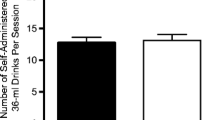Abstract
Methodological comparisons of procedures for drug self-administration are rare. In studies examining the reinforcing effect of caffeine in humans, caffeine self-administration usually has been inferred from performance under forced-choice procedures. In the present experiment, caffeine self-administration via coffee was compared under forced-choice and free-choice conditions; i.e., when subjects were and were not required to use a minimum number of coffees. Ten moderate coffee drinkers (2–7 cups/day) were assigned to forced- and free-choice conditions using a randomized cross-over design. Under each choice condition, subjects completed six independent, double-blind trials, consisting of a 2-day exposure period followed by a 2-day test period. During exposure, subjects consumed either decaffeinated or caffeinated (100 mg/serving) coffee on day 1 and the other coffee on day 2. During the test period, subjects had concurrent access to the same decaffeinated and caffeinated coffees. Under the forced-choice condition, subjects were required to drink at least four cups of coffee per day during the test period. Under the free-choice condition, subjects did not have a minimum-cup requirement. In general, the relative rate at which subjects self-administered caffeinated versus decaffeinated coffee was similar across choice conditions, even though subjects self-administered significantly fewer cups of both coffee types under the free-choice than the forced-choice condition. These results suggest that, at least for caffeine, forced-choice and free-choice procedures produce comparable results. Whether this finding generalizes to a context in which caffeine or another drug is more robustly self-administered, remains to be determined.
Similar content being viewed by others
References
American Psychiatric Association (1987) Diagnostic and statistical manual of mental disorders, 3rd edn — revised. American Psychiatric Association, Washington, DC
Amerine MAA, Pangborn RM, Roessler EG (1965) Principles of sensory evaluation of food. Academic Press, New York, NY
Fleiss JL (1981) Statistical methods for rates and proportions. Wiley, New York, NY
Greden JF (1981) Caffeinism and caffeine withdrawal. In: Lowinson JH, Reiz P (eds) Substance abuse: clinical problems and perspectives. Williams and Wilkins, Baltimore, MD, pp 274–286
Griffiths RR, Woodson PP (1988a) The reinforcing effects of caffeine in humans. J Pharmacol Exp Ther 246:1–8
Griffiths RR, Woodson PP (1988b) Reinforcing properties of caffeine: studies in humans and laboratory animal. Pharmacol Biochem Behav 29:419–427
Griffiths RR, Woodson PP (1988c) Caffeine physical dependence: a review of human and laboratory animal studies. Psychopharmacology 94:437–451
Griffiths RR, Bigelow GE, Liebson IA (1986) Human coffee drinking: Reinforcing and physical dependence producing effects of caffeine. J Pharmacol Exp Ther 239:416–425
Griffiths RR, Bigelow GE, Liebson IA (1989) Reinforcing effects of caffeine in coffee and capsules. J. Exp Anal Behav 52:127–140
Hughes JR, Hatsukami DK (1986) Signs and symptoms of tobacco withdrawal. Arch Gen Psychiatry 43:289–294
Hughes JR, Amori G, Hatsukami DK (1988) A survey of physician advice about caffeine. J Subs Abuse 1:67–70
Hughes JR, Higgins ST, Bickel WK, Hunt WK, Fenwick JW, Gulliver SB, Mireault GC (1991) Caffeine self-administration, withdrawal and adverse effects among coffee drinkers. Arch Gen Psychiatry 48:611–617
Hunt WK, Hughes JR, Bickel WK, Higgins ST, Pepper S (1990) Effects of dose on the reinforcing effects of caffeine. Pharmacol Biochem Behav 36:440
Jacob P III, Wilson M, Benowitz NL (1981) Improved gas chromatographic method for the determination of nicotine and cotinine in biological fluids. J Chromatogr 222:61–70
McLeod DR, Griffiths RR, Bigelow GE, Yingling J (1982) An automated version of the digit symbol substitution test (DSST). Behav Res Meth Instrum 14:463–466
McNair DM, Lorr M, Droppelman LF (1971) Manual for the profile of mood states. Educational and Industrial Testing Service, San Diego, CA
Schreiber GB, Maffeo CE, Robins M, Masters MN, Bond AP (1988) Measurement of coffee and caffeine intake: Implications for epidemiologic research. Preven Med 17:280–294
Stern KN, Chait LD, Johanson CE (1989) Reinforcing and subjective effects of caffeine in normal human volunteers. Psychopharmacology 98:81–88
Author information
Authors and Affiliations
Additional information
Supported by grant DA-04843, T32-DA07242, and Research Scientist Development Award DA-00109 (J.R.H) from the National Institute on Drug Abuse.
Rights and permissions
About this article
Cite this article
Oliveto, A.H., Hughes, J.R., Higgins, S.T. et al. Forced-choice versus free-choice procedures: Caffeine self-administration in humans. Psychopharmacology 109, 85–91 (1992). https://doi.org/10.1007/BF02245484
Received:
Revised:
Issue Date:
DOI: https://doi.org/10.1007/BF02245484




